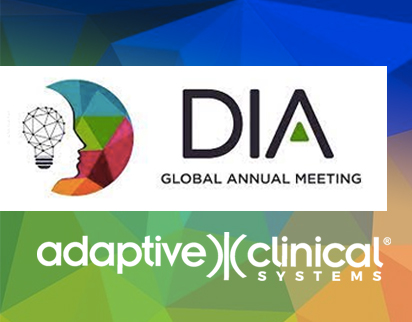DCT and the need for interoperability are here to stay, and they are moving forward in hyper-drive.
The DIA Virtual Meeting 2021 is in the books, and there were some tremendous highlights and lessons learned from clinical trials during COVID19. Many of the sessions focused on key issues facing industry and regulatory leaders as they work for the most accurate, quality data in a timely manner. A strong clinical trial operational framework enabled by full across-system interoperability is critical for data accuracy and data quality with the growing complexity of decentralized and hybrid trials.

Adaptive Clinical was thrilled that DIA created different ways for attendees to opt-in to share their information. It is exciting for those who want to network and share that you can choose to do that selectively.
As life sciences professionals from around the world gathered these were some focused, innovative discussions: AI, ML, interoperability, decentralized clinical trials, hybrid trials, patient involvement, real-world evidence, improving communication and driving collaboration. Amazing examples could be found everyday across this diverse conference.
Many session speakers presented innovative uses of AI and ML, but many lamented that getting clean harmonized data from all the necessary sources was their biggest short-coming. Some would even say that lack of fluid exchange of data from sources to AI/ ML engines is presently the biggest impediment to innovation.
The other good news is that there are several initiatives ranging from TransCelerate to eHDSI, spearheaded by the EMA (this one even aims to address multi-lingual data) committed to tackling the lack of interoperability across all the tools in our domain. In the meantime though, the Adaptive eClinical Bus intelligent middleware is at the ready to help overcome these challenges..

Pandemics Drive Sustainable Change
The DIA Keynote address provided by Kenneth Frazier, Retired CEO, Merck, focused on how pandemics have historically driven sustainable change. Citing examples from global pandemics, Frazier noted innovations from many of these events, including:
► The plague in the late 1800s led to the development of serum therapies and randomized control trials.
► Smallpox led to innovation in variolation therapy.
► The 1918 influenza led to a much deeper understanding of the social determinants of health.
► More recently, HIV-focused research led to the development of SARS2 antivirals.
Frazier is hopeful for more investment in durable preparedness innovation. Looking to the future, he sees accelerating healthcare digitalization, using telehealth as an example. Frazier spoke of environmental evolution in building design, affecting everything from restaurants to medical facility waiting rooms. Looking ahead, he is hopeful for improved collaboration among competitors and acting on a deeper understanding of the social determinants of health, to help poor and disadvantaged communities that are impacted disproportionately.
Following the keynote, the panelists focused on how the COVID19 era has been characterized by a strong anti-science bias among large swaths of the public in many countries and discussed the need to combat this trend and offered strategies to address the issue. Panelists Melanie Carr, Head of Stakeholders and Communication Division, European Medicines Agency; Brian Southwell, Senior Director, Science in the Public Sphere, Center for Communication Science, RTI International; Richardae Araojo, Associate Commissioner for Minority Health, Director, Office of Minority Health, FDA; and Briony Swire-Thompson, Senior Research Scientist, Lazer Lab, Northeastern University Network Science Institute.


The panel recognized that both misinformation and disinformation spread for legitimate reasons as individuals and communities try to make sense of what is happening and to find hope for answers. This requires more compassion and empathy and less blame on patients
The panel noted the need to understand how people gather information and encourage them in their vested interest to get good information. It is important to actively listen to the information directed at specific communities, to better understand what they are being told, how they perceive this information, and how to proactively respond to it. The entire healthcare community must collaborate to combat dis and misinformation. By joining forces across disciplines, it can raise awareness of reputable sources.
Patient-First Models Highlight Patient Input
At Adaptive Clinical, we found many panels and posters that looked to improve patient input, focus on patient centricity, coached on how best to place the patient first, as well as advance patient diversity and patient communications. At the heart of all research is the goal to provide better medicines, devices, and therapies. This panel focused on the value of qualitative patient data and patient input at the earliest stages of research and development. A great panel on the value of the Patient first, “Advancing the Science of Patient Input: How are WE doing?” Great input from the FDA, advocacy groups and Industry!
Panelists included: Pujita Vaidya, Global Regulatory and R&D Policy Director, Amgen; Robyn Carson, Vice President, Patient Centered Outcomes Research, Abbvie; David Reasner, Division Director, Division of Clinical Outcome Assessment, OND, CDER, FDA; Jessica Scott, Head of R&D Patient Engagement Office, Takeda Pharmaceutical Company; Annie Kennedy, Chief of Policy and Advocacy, EveryLife Foundation for Rare Diseases and Michelle Tarver, Deputy Director, Office of Strategic Partnerships & Technology Innovation, CDRH, FDA.


Consider the device:
► Privacy requirements
► Device quality and capabilities
► User Experience
►Validation to protocol
► Vendor experience
► Connectivity
► Data verification
► Interest and engagement
And then the data itself:
► Missing data
► Source data verification
► Data capture
► Noise and user training
► Quality content
► Sustained engagement
This panel explored how patient involvement is growing in all aspects of clinical trials, and at the grass roots level as advocacy groups focus first data outputs. Panelists discussed how regulatory, industry and consumer advocacy groups can best leverage the patient experience and build communications that make it easier for patients to be involved in decentralized clinical trials. As new devices begin to migrate into practice – they provide the opportunity for RWE and RWD. David Reasner encouraged early engagement and early consideration of tools by industry for clinical trials, and a metered approach to data goals and outcomes. Patient experience data of all types and availability are available in regulatory decision-making.
Michelle Tarver noted the Patient Advisory Committee has provided actionable outputs for use by care givers, advocates, and clinical trial managers for the patient. The goal of this committee and these activities by the FDA is to empower patients to make informed decisions about care, and to help recruit patients from cultural or diverse populations.
Patient Studies Highlight a Preference for DCT
Decentralized and hybrid clinical trials involve more than apps and digital tools. We should be mindful of pushing burden downstream to investigators and patients, as their perspectives on decentralizing and operationalizing studies will impact regulatory, quality, supply management, and data harmonization. In a presentation titled, “Managing Stakeholders in the Decentralized and Hybrid Clinical Trial Ecosystem” we learn that DCT movement is a lot more than technology and design, and that these primary stakeholders are key drivers of successful clinical trials – or not.
Presenters:
E.B McLindon | ICON Senior Vice President, Patient, Site & Decentralized Solutions ICON plc
Isaac Rodriguez-Chavez PRA | Senior Vice President, Scientific and Clinical Affairs, Head, Global COE PRA Health Sciences
In a 2-year longitudinal survey of over 4,000 patients, respondents clearly indicate they wanted options in study methods and tools.
► Preference of study visit location: 30% hybrid, 33% no preference
► Would consider participation if all visits are virtual: 57%
► Location of clinical trial tests: site 26%; convenient location 37%
► Prefer digital patient diaries vs. paper: 70%
Sites appear to have stronger opinions about participating in DCT trials. They see benefits to both patients and to staff.
► 78% see a lot or some benefit vs 16% recording little or no patient benefit
► 63% see a lot or some benefit vs 22% recording little or no patient benefit
► For both patients and staff, the greatest perceived therapeutic benefits were in cardiology (83%), while the least beneficial was oncology (75% and 72% respectively)

Industry faces continuing challenges to improve the experience and efficiency and effectiveness of the clinical trials process. Interoperability is the enabler of bringing disparate technologies together and is a critical capability to realizing the potential of DCT.
In a May 2021 industry survey, fully 83% of respondents reporting including DCT/digital elements in studies planned in the next year. At the same time 59% of these same respondents admitted to not having the internal capabilities to implement a DCT/digital trial.

Technologies currently in use in DCTs among healthcare providers continue to expand and trend from what began as platform solutions to more specialized technologies:
► 77% – mobile technologies (eConsent, EHR, etc.)
► 60% – wearables
► 54% – in-home devices
► 35% – sensors
► 31% – AI and ML
Of the survey responses it becomes clear that the patient is considered the primary beneficiary of the DCT movement:
► 53% – patient convenience
► 13% – shorter trial timelines
► 11% – more diverse patient populations
► 10% – Reduced cost
Interoperability is required in DCTs as data streams evolve into a synergistic melding of three perspectives: improved data flow, patient centricity, and emerging technologies. Fit-for- purpose advances will involve interoperability of data from medical, clinical, operational, legal, regulatory, quality, and technology perspectives.
The ultimate outcome these authors envision is integrating DCT and clinical research as a care option (CRAACO). In this world, multiple holistic capabilities of DCT are embedded in the healthcare delivery continuum. Benefits will include improved participant access to new therapies, expedited drug development, improved data quality, increased patient retention, and improved outcomes for patients, payers, and providers.

DCT is Here to Stay
Just as the keynote address focused on growing collaboration and innovation, this panel delved further into DCT – “Syneos Innovation Theatre: Partnering to Innovate the Way Forward for Decentralized Clinical Trials” looked at the options for hybrid trials – a spectrum of study designs from traditional on-site to remote + on-site to fully remote.
Presenters:
Noolie Gregory | Vice President, Clinical Trial Operations
Scott Scarola | Vice President, Clinical Trial Operations
As you design study protocols, study managers must:
► Assess the value
► Apply the right tools and partners
– Avoid a situation where you cannot incorporate a given technology because your platform does not allow it or have the flexibility
– The solutions you choose need to be able to scale
► Leverage infrastructure efficiencies to deliver success (e.g., data flows etc.)
► Be aware of what regulators do not allow to be done in-home
As you move into DCT production, consider five areas:
► DCT and Infrastructure: OP&s, processes, tools, templates
► Data flow and interoperability: Integration, data integrity and security
► Standardized Oversight: Analytics, the ability to look at new data in different ways
► Regulatory and Intelligence: Important and nuanced differences across markets that are changing rapidly
► Industry Intelligence: Industry Initiatives and Knowledge Base
Our Point of View
A number of speakers also observed that the increased complexity of DCTs is making it impossible to get a singular view of your study as the data is scattered across many different tools with no way to have a holistic view of them all.
Finally, there are a lot of different technologies. How do you get them all on a platform? At Adaptive Clinical Systems, we believe that sponsors and sites should have the ability to work with best of breed partners. For more than a decade, Adaptive Clinical has worked with many partners and providers and can assist with your interoperability and data aggregation and data quality concerns. Adaptive DataVIEW delivers true interoperability and provides a “preview” of harmonized data coming from labs, monitoring tools or med devices prior to their loading into EDC or customer data lakes. In many cases, this is presently done using Excel as these products do not allow viewing of their output in aggregate.
Net: DCT is here to stay, and it is moving forward in hyper-drive.

About Adaptive Clinical
